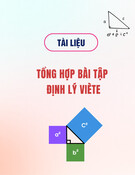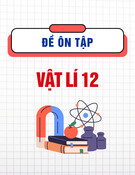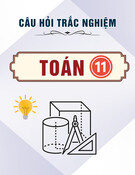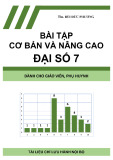
VOCABULARY SET 25: CAR-
FREE DAYS
Vocabulary:
1. advocate (n): nh ng ng i ch tr ng/tánữ ườ ủ ươ thành
2. atmosphere (n) - atmospheric (adj): không khí, khí quy nể
3. contaminant (n) - contaminate (v): (ch t) gây ôấ nhi mễ
4. contribute (v): đóng góp
5. culprit (n): nguyên nhân
6. curtail (v): rút ng n, c tắ ắ b tớ
7. designate (v): ch đnh, dànhỉ ị riêng
8. emission (n): khí thái, ch tấ th iả
9. eschew (v): tránh làm vi c gìệ đó
10. exaggerate (v) - exaggeration (n): c ng đi u hóa, phóngườ ệ điạ
11. exert (v); n l c t oỗ ự ạ thành
12. flaw (v/n): khuy t đi m, thi uế ể ế sót
13. fume (n): khói
14. guarantee (v): b o đm, camả ả đoan
15. holistic (adj): toàn di nệ
16. levy (v): đánh thuế
17. long-lasting (adj) - longer-lasting (comparative adj): lâu dài, b nề bỉ
18. mere (adj): ch (đn thu n)ỉ ơ ầ là
19. reduce (v) - reduction (n): gi mả b tớ
20. short-term - long-term (adj): ng n h n - dàiắ ạ h nạ
21. significant (adj): đáng kể
22. ubiquity (n) - ubiquitous (adj): có m t m iặ ở ọ n iơ
Exercises:
Task 1: Write sentences from given cues. Make changes to the cues when needed.
1. area / park / be / specially / designate / children.
2. much / coast / be / contaminate / nuclear waste.
3. high / cost / fuel / sure / curtail / holiday travel / this year.
4. outspoken / singer / be / advocate / gay and lesbian / right.

5. he / tend / exaggerate / when / talk / about / accomplishment

Task 2: Translate from Vietnamese to English
1. Sau nhi u nghiên c u, các nhà khoa h c đã tìm ra nguyên nhân c a căn b nh là do r i lo nề ứ ọ ủ ệ ố ạ gien.
2. M cặ dù tôi thích u ngố cà phê, tôi đã l aự ch nọ tránh th cứ u ngố này b iở nh ngữ tác h iạ cà phê mang
t iớ
cho ràng mi ng tôi. ệ
3. Khi nhà c mầ quy nề quy tế đnhị đánh thêm thuế vào các s nả ph mẩ thu cố lá, nh ngữ ng iườ hút thu cố
đã
tràn ra đng ph đ bi u tình.ườ ố ể ể
4. Cách ch aữ trị toàn di nệ mà bác sỹ c aủ tôi đaư ra bao g mồ th oả m cộ và các lo iạ vitamin giúp nâng
cao
s c kh e.ứ ỏ
5. T c a s khách s n, tôi có th nhìn th y khí th i ô nhi m t m t nhà máy li nừ ử ổ ạ ể ấ ả ễ ừ ộ ề k .ề
Task 3: Fill in the blanks with suitable words/phrases

Some people think international car-free days are an effective way of reducing air pollution, others
think there are some other ways. Discuss both views and give your own opinion.
The 1 of cars is often considered as a major 2 of air quality degradation in
many countries. To combat 3 pollution, many suggest that car-free days should be held
internationally. However, I contend that these events may achieve little success, and there are more
effective methods to preserve the atmosphere.
4 of organising global car-free days may argue that the absence of cars promotes the use
of public transport and activities such as cycling and walking, which all 5 considerably to
the 6 of traffic emissions. This argument, from my perspective, is 7 , because of
two facts. The first is that a few days without cars out of 365 days of the year may help cut down as little
as one percent of the annual amount of traffic 8 , so the assertion that this
9 reduction is 10
is a 11 . The second is that this solution does not
limit the massive amount of air 12 being released from industrial zones. It is therefore a one-
sided approach and arguably not an effective way to address the problem of air pollution.
There are, in myopinion, better measures to minimise air pollution. One of them is constructing
dedicated lanes for public means of transport. These lanes 13 that public transport is
relatively faster than individual vehicles in rush hours, which may encourage a majority of commuters to
14 their personal vehicles in favour of mass transit. The implication is that motor vehicle use
may be reduced throughout the year, which 15 a 16 impact on minimising
traffic fumes than international car free days may do. Another measure is 17 a tax on carbon
usage in all areas, including transport and industrial production.This measure has been adopted in several
countries including the United Kingdom, and has proven its effectiveness as a 18 approach
to 19 in all fields.
To sum up, I believe the organisation of world car free days may produce little effect on protecting the
atmosphere. Other solutions, namely building 20 lanes for public vehicles and taxing all
industries on carbon usage, produce more sustainable effects on a larger scale.
354 words, written by Tu Pham

Key:
Task l:
1. This area of the park has been specially designated for children.
2. Much of the coast has been contaminated by nuclear waste.
3. The high cost of fuel is sure to curtail holiday travel this year.
4. The outspoken singer is an advocate for gay and lesbian rights.
5. He tends to exaggerate when talking about his accomplishments.
Task 2: Answers may vary
1. After much research, scientists identified the culprit of the disease as a genetic disorder.
2. Even though I love coffee, I have chosen to eschew the beverage because of the damage it does to my
teeth.
3. When the governor decided to levy additional fees on tobacco products, smokers took to
the streets in protest.
4. The holistic treatment prescribed by my doctor includes herbs and vitamins that will improve my
general well-being.
5. From the hotel window, I could see the emission of pollutants coming from a nearby factory.
Task 3
The (1) ubiquity of cars is often considered as a major (2) culprit of air quality degradation in many
countries. To combat (3) atmospheric pollution, many suggest that car-free days should be held
internationally. However, I contend that these events may achieve little success, and there are more
effective methods to preserve the atmosphere.
(4) Advocates of organising global car-free days may argue that the absence of cars promotes the use
of public transport and activities such as cycling and walking, which all (5) contributes considerably to
the (6) reduction of traffic emissions. This argument, from my perspective, is (7) flawed, because of two
facts. The first is that a few days without cars out of 365 days of the year may help cut down as little as
one percent of the annual amount of traffic (8) fumes, so the assertion that this (9) short-term reduction
is (10) significant is a (11) mere exaggeration. The second is that this solution does not limit the massive
amount of air (12) contaminants being released from industrial zones. It is therefore a one-sided
approach and arguably not an effective way to address the problem of air pollution.
There are, in my opinion, better measures to minimise air pollution. One of them is constructing
dedicated lanes for public means of transport. These lanes (13) guarantee that public transport is
relatively faster than individual vehicles in rush hours, which may encourage a majority of commuters to
(14) eschew their personal vehicles in favour of mass transit. The implication is that motor vehicle use
may be reduced throughout the year, which (15) exerts a (16) longer-lasting impact on minimising
traffic fumes than international car free days may do. Another measure is (17) levying a tax on carbon
usage in all areas, including transport and industrial production. This measure has been adopted in several
countries including the United Kingdom, and has proven its effectiveness as a (18) holistic approach to
(19) curtail emissions in all fields.
To sum up, I believe the organisation of world car free days may produce little effect on protecting the
atmosphere. Other solutions, namely building (20) designated lanes for public vehicles and taxing all
industries on carbon usage, produce more sustainable effects on a larger scale.





![Bài tập so sánh hơn và so sánh nhất của tính từ [kèm đáp án/mới nhất]](https://cdn.tailieu.vn/images/document/thumbnail/2025/20250808/nhatlinhluong27@gmail.com/135x160/77671754900604.jpg)
![Tài liệu tham khảo Tiếng Anh lớp 8 [mới nhất/hay nhất/chuẩn nhất]](https://cdn.tailieu.vn/images/document/thumbnail/2025/20250806/anhvan.knndl.htc@gmail.com/135x160/54311754535084.jpg)




![Tài liệu Lý thuyết và Bài tập Tiếng Anh lớp 6 [Mới nhất]](https://cdn.tailieu.vn/images/document/thumbnail/2025/20250802/hoihoangdang@gmail.com/135x160/18041754292798.jpg)




